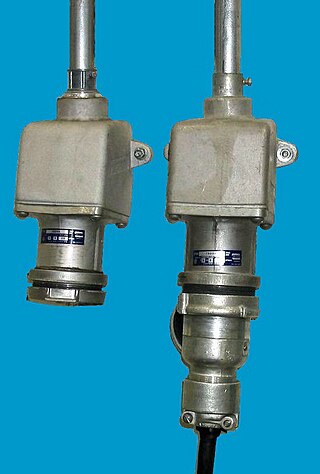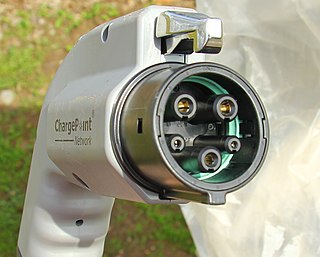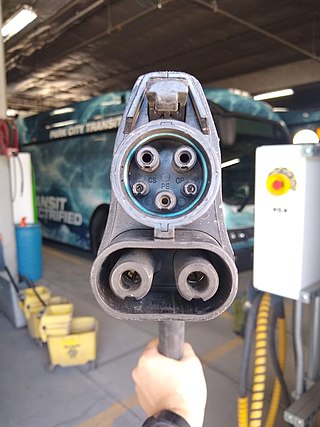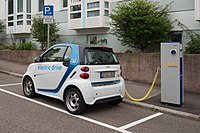
A DC connector is an electrical connector for supplying direct current (DC) power.

IEC 60320 Appliance couplers for household and similar general purposes is a set of standards from the International Electrotechnical Commission (IEC) specifying non-locking connectors for connecting power supply cords to electrical appliances of voltage not exceeding 250 V (a.c.) and rated current not exceeding 16 A. Different types of connector are specified for different combinations of current, temperature and earthing requirements. Unlike IEC 60309 connectors, they are not coded for voltage; users must ensure that the voltage rating of the equipment is compatible with the mains supply. The standard uses the term coupler to encompass connectors on power cords and power inlets and outlets built into appliances.
AC power plugs and sockets connect electric equipment to the alternating current (AC) mains electricity power supply in buildings and at other sites. Electrical plugs and sockets differ from one another in voltage and current rating, shape, size, and connector type. Different standard systems of plugs and sockets are used around the world.

IEC 60309 is a series of international standards from the International Electrotechnical Commission (IEC) for "plugs, socket-outlets and couplers for industrial purposes". They are also referred to as "pin & sleeve" connectors in North America or as "CeeForm" connectors in the entertainment industry. The maximum voltage allowed by the standard is 1000 V DC or AC; the maximum current, 800 A; and the maximum frequency, 500 Hz. The ambient temperature range is −25 °C to 40 °C.

Mains electricity by country includes a list of countries and territories, with the plugs, voltages and frequencies they commonly use for providing electrical power to low voltage appliances, equipment, and lighting typically found in homes and offices. Some countries have more than one voltage available. For example, in North America the supply to most premises is split-phase, with 240 volts between phases and 120 volts between either phase and neutral. Most sockets are connected to 120 V and neutral. By connecting across the phases, 240 V is available for large appliances. Often different sockets are mandated for different voltage or current levels.

Industrial and multiphase plugs and sockets provide a connection to the electrical mains rated at higher voltages and currents than household plugs and sockets. They are generally used in polyphase systems, with high currents, or when protection from environmental hazards is required. Industrial outlets may have weatherproof covers, waterproofing sleeves, or may be interlocked with a switch to prevent accidental disconnection of an energized plug. Some types of connectors are approved for hazardous areas such as coal mines or petrochemical plants, where flammable gas may be present.
Avcon is a company that manufactures charging interfaces for battery electric vehicles (EV). The lettering convention is Avcon for the company and AVCON (capitals) for the EV charging connector.

A charging station, also known as a charge point or electric vehicle supply equipment (EVSE), is a power supply device that supplies electrical power for recharging plug-in electric vehicles.

SAE J1772, also known as a J plug or Type 1 connector after its international standard, IEC 62196 Type 1, is a North American standard for electrical connectors for electric vehicles maintained by SAE International under the formal title "SAE Surface Vehicle Recommended Practice J1772, SAE Electric Vehicle Conductive Charge Coupler".

CHAdeMO is a fast-charging system for battery electric vehicles, developed in 2010 by the CHAdeMO Association, formed by the Tokyo Electric Power Company and five major Japanese automakers. The name is an abbreviation of "CHArge de MOve" and is derived from the Japanese phrase "o CHA deMO ikaga desuka" (お茶でもいかがですか), translating to English as "How about a cup of tea?", referring to the time it would take to charge a car.

Mennekes Elektrotechnik GmbH & Co. KG is a German manufacturer of industrial plugs and connectors with headquarters in Kirchhundem in the Sauerland region, Germany.

IEC 62196Plugs, socket-outlets, vehicle connectors and vehicle inlets – Conductive charging of electric vehicles is a series of international standards that define requirements and tests for plugs, socket-outlets, vehicle connectors and vehicle inlets for conductive charging of electric vehicles and is maintained by the technical subcommittee SC 23H “Plugs, Socket-outlets and Couplers for industrial and similar applications, and for Electric Vehicles” of the International Electrotechnical Commission (IEC).

Plugs and sockets for electrical appliances not hardwired to mains electricity originated in the United Kingdom in the 1870s and were initially two-pin designs. These were usually sold as a mating pair, but gradually de facto and then official standards arose to enable the interchange of compatible devices. British standards have proliferated throughout large parts of the former British Empire.

The Combined Charging System (CCS) is a standard for charging electric vehicles. It can use Combo 1 (CCS1) or Combo 2 (CCS2) connectors to provide power at up to 350 kilowatts (kW) . These two connectors are extensions of the IEC 62196 Type 1 and Type 2 connectors, with two additional direct current (DC) contacts to allow high-power DC fast charging. In response to demand for faster charging, 400 kW CCS chargers have been deployed by charging networks and 700 kW CCS chargers have been demonstrated.

The IEC 62196 Type 2 connector is used for charging electric vehicles, mainly within Europe, as it was declared standard by the EU. Based on widespread red IEC 60309 three phase plugs with five pins, which come in different diameters according to maximum current, a single size was selected, as maximum possible power will be communicated to the car via two additional communication pins and by a simple resistor coding within the cable. The onboard charger inside the car has to limit the current accordingly.

IEC 61851 is an international standard for electric vehicle conductive charging systems, parts of which are currently still under development(written 2017). IEC 61851 is one of the International Electrotechnical Commission's group of standards for electric road vehicles and electric industrial trucks and is the responsibility of IEC Technical Committee 69 (TC69).

SAE J3068 "Electric Vehicle Power Transfer System Using a Three-Phase Capable Coupler" is a North American recommended practice published and maintained by SAE International. J3068 defines electrical connectors and a control protocol for electric vehicles. It has the formal title "SAE Surface Vehicle Recommended Practice J3068". J3068 defines a system of conductive power transfer to an electric vehicle using a coupler capable of transferring single-phase and three-phase AC power as well as DC power, and defines a digital communication system for control. J3068 also specifies requirements for the vehicle inlet, supply equipment connector, mating housings and contacts.
The GB/T charging standard is a set of GB/T standards, primarily in the GB/T 20234 family, for electric vehicle AC and DC fast charging used in China. The standards were revised and updated most recently in 2015 by the Standardization Administration of China. The term is an abbreviation of 国标推荐 (guóbiāo/tuījiàn), translated as "recommended/voluntary national standard".

The ChaoJi connector, also referenced as CHAdeMO 3.0, is an ultra-high-power charging standard charging electric cars, released in 2020. The connector has a lemniscate shape (∞), with a flat bottom edge and is planned for charging battery electric vehicles at up to 900 kilowatts using direct current. The design incorporates backward compatibility with CHAdeMO and the GB/T DC-charging, using a dedicated inlet adapter for each system. The circuit interface of ChaoJi is also designed to be fully compatible with the Combined Charging System, also known as CCS.

The Megawatt Charging System (MCS) is a charging connector under development for large battery electric vehicles. The connector will be rated for charging at a maximum rate of 3.75 megawatts.



















